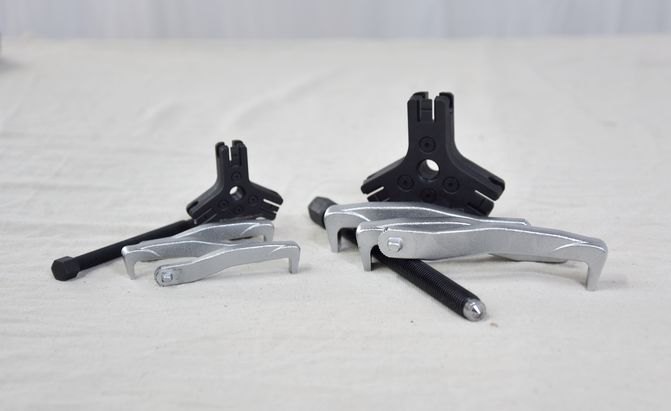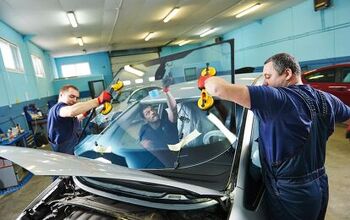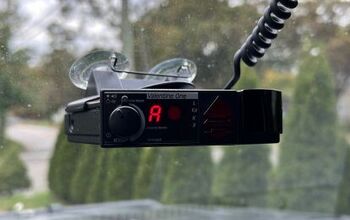Shop Favorite: GEARWRENCH Ratcheting Bearing Puller Test and Review

We’ve used a bearing puller for years, and always with a little dread. We never owned our own, and borrowing one from a friend or using it in another shop is always an adventure. Any time you pick one up, you know you’re going to be fumbling with it when you try to get the little jaws in place while screwing it down. You usually need a rubber band, a third hand, and reserves of calm we don’t have. It’s a problem so difficult that NASA designs their own.
So when the time came to buy our own gear puller, we were looking for something different. The GEARWRENCH 2 or 3 Jaw Internal/External Ratcheting Bearing Puller Set not only had great reviews, but a set of unique features that promised to make it a better experience than traditional three jaw pullers. And as a bearing puller is a “use it once and it pays for itself” tool that you’ll need to do all sorts of more advanced repairs (and some basic ones, as you’ll see), it made sense to get one we wouldn’t regret.
The core of the puller tool set is a pair of modular center sections. The puller arms snap in, and—and this is big—ratchet into place. That’s right, once you put them in place, they stay in place, with little built-in retainers. At first, we had enough difficulty getting them in that we thought we were going to have trouble using it, but after one or two uses, it became second nature. But as cool as the ratchet function is, the ability to set it up as either a two jaw puller or three jaw puller is what elevates it above other tools. Oh, and of course you can easily reverse the jaws, too.
Table of contents
What's in the Case
We're not huge fans of molded plastic cases, as they all eventually crack and turn into plastic waste, but at least the GEARWRENCH set comes in a thick, solid one that won't break with normal use around the shop. It does a good job of holding everything securely, and in a logical, easy-to-find order, which you can't always count on.
The kit comes with the two modular center sections, three arms for each, and a screw for each. We think that for the price there should be a couple of extra replaceable tips in there, although you'll have to use it a lot to wear them out.
GEARWRENCH Bearing Puller Set Construction

The body, arms, and screws are all alloy steel. The body is bolted together, and the spring retainer is built into a top plate. We don't think it would ever break in normal use, but if it did, you could replace it.
The jaws of the arms are thinner than we're used to seeing on comparable sets. It's possible you could break one if you really cranked on it, but it also gives you a little more clearance for tight jobs. The five-ton has a coarse thread screw, and the two-ton a fine thread. There's a little more play in the coarse threads than is ideal, although we didn't see any wear.
The five ton screw has a replaceable steel tip with ball detent.
We like the replaceable hardened tip on the big screw, but you'd have to contact GEARWRENCH for a new one. It would have been nice to have a spare included in the set.
Using the GEARWRENCH Bearing Puller Set
Once you press the jaws in, the spring holds them in place. The ratcheting action comes from grooves in the end of the arms. We found it worked extremely well, but over time, they'd either wear down, wallow out the hole, or both, depending on which is harder. We'd expect that to be covered under warranty.
You might think this is a specialty tool for engine or suspension building, and we bought it for a brake project, but the first time we used it was for...a wiper blade change. It turned out that the rear arm on our project 2005 Dodge Magnum RT had broken, and, after a decade-and-a-half of New England, had completely fused onto the shaft.
We're not sure how else we could have done this job, and it was incredibly satisfying when it popped off, showing that the shaft and bushing had indeed rusted together into one piece. The alternatives would have been taking the inside panel off and trying to unbolt it from the motor, which was doubtful; or spending the time and money taking it to a garage. Either way, it almost certainly paid for itself.
GEARWRENCH Warranty and Customer Service
GEARWRENCH offers a limited lifetime warranty on it's bearing puller, and there are easy to-find toll-free numbers and email contact forms on the gearwrench.com site. There aren't any instructions, either with the product or on the site.
The GEARWRENCH #3627 2 or 3 Jaw Internal/External Ratcheting Puller Set has a great 93% positive rating from over 300 reviews; and a similar but slightly more specialized long-leg five-ton version has an even better rating.
GEARWRENCH Bearing Puller Set Conclusions
Our reservations are minor, at best. The biggest is that the arm design means you can't close the jaws as tightly as a conventional design—there's about a one-inch minimum diameter to grab onto. In the photo of using it on the Dodge in the previous section, that's absolutely as tight as it goes. We're concerned the ratchet mechanism will wear out over time, but in reality, that would be hundreds, if not thousands of uses. Even in daily use, you should still get years out of it.
Compared to the frustration of using a regular bearing puller, none of this matters very much. Just picking the thing up feels great, and it's incredibly convenient to be able to switch between a two jaw puller and three jaw puller in seconds just by moving the arms. There are some tools you find excuses to avoid, and some you find reasons to use. We're already planning new projects for this one.
Pros | Stays in the position you put it in, slim jaws are great for tight spaces, two- or- three jaw flexibility |
Cons | Doesn't close as tight as conventional gear pullers |
Bottom Line | After extensive research, this is the puller tool we use in the AutoGuide Garage |
We are committed to finding, researching, and recommending the best products. We earn commissions from purchases you make using the retail links in our product reviews. Learn more about how this works.
AutoGuide may accept review samples for testing and evaluation. Suppliers of review products do not have any input into our conclusions and are not allowed to review our content before publication.

After completing a degree project in automotive design, Dave wrote and photographed for almost a decade in print car magazines (remember those?), before transitioning to digital. He now subjects a series of old high-performance cars to the roads and weather in Vermont and wonders why they're always expensively broken. Please stop when you see him crawling under one on the side of the road.
More by David Traver Adolphus





































Comments
Join the conversation